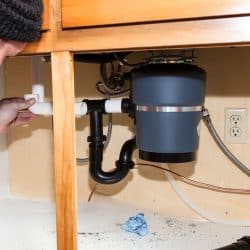Top Tips for Fixing a Leaking Waste Disposal Unit
Top Tips for Fixing a Leaking Waste Disposal Unit
Blog Article
The publisher is making several good pointers relating to Why Is My Garbage Disposal Leaking From the Bottom? in general in this post on the next paragraphs.

Waste disposal unit are necessary cooking area devices that help in disposing of food waste successfully. Nonetheless, a dripping garbage disposal can be an aggravating and untidy issue to take care of. Luckily, several leaks can be fixed easily with a few straightforward steps. In this article, we will review just how to deal with a dripping waste disposal unit successfully.
Introduction
Garbage disposals are set up under kitchen sinks and are designed to shred food waste into smaller sized items, allowing it to travel through the pipes system quickly. While these tools are typically trusted, leakages can happen in time due to damage, loosened connections, or damage to the device.
Typical Root Causes Of Leaks in Waste Disposals
Worn Seals and Gaskets
Seals and gaskets play a vital role in preventing water from dripping out of the waste disposal unit. With time, these parts can weaken, leading to leaks around the disposal device.
Loose Links
The connections in between the garbage disposal and the pipes system can come to be loose over time, triggering water to leak out throughout procedure.
Cracks or Openings in the Disposal System
Physical damage to the garbage disposal, such as splits or holes in the housing, can likewise result in leakages.
Identifying the Source of the Leakage
Before trying to repair a dripping garbage disposal, it is vital to identify the resource of the leak. This can typically be done with aesthetic evaluation or by carrying out simple tests.
Visual Assessment
Examine the waste disposal unit unit thoroughly for any type of signs of water leakage. Pay very close attention to locations around seals, gaskets, and connection factors.
Examining for Leakages
One way to examine for leaks is by running water via the disposal unit and looking for any visible indicators of leakage.
Tools and Products Needed for Fixing a Leaking Waste Disposal Unit
Before beginning the repair service procedure, collect the necessary tools and products, consisting of a screwdriver, adjustable wrench, plumber's putty, replacement seals or gaskets, and epoxy or patching product for fixing splits or openings.
Step-by-Step Guide to Repairing a Dripping Garbage Disposal
Shut off the Power
Before attempting any kind of repair work, guarantee that the power to the waste disposal unit device is switched off to stop the threat of electrical shock.
Find the Leak
Identify the precise place of the leakage and figure out the reason.
Tighten up Links
Use a wrench to tighten up any type of loosened links in between the disposal device and the pipes system.
Change Seals or Gaskets
If the leakage results from used seals or gaskets, get rid of the old parts and replace them with new ones.
Patching Fractures or Openings
For cracks or holes in the disposal device, usage epoxy or an appropriate patching product to secure the broken location.
Checking the Waste Disposal Unit After Fixing
When the repair service is total, test the garbage disposal by running water via it to make certain that the leakage has actually been settled.
Preventive Upkeep Tips to Prevent Future Leakages
To stop future leakages, it is necessary to perform normal upkeep on your garbage disposal. This consists of maintaining it clean, avoiding putting non-food products or hard objects down the disposal, and occasionally looking for leaks or other concerns.
Verdict
To conclude, repairing a dripping garbage disposal is a reasonably uncomplicated procedure that can be completed with standard devices and materials. By adhering to the actions outlined in this short article and exercising preventive maintenance, you can keep your waste disposal unit in good working condition and avoid pricey fixings in the future.
What to Do About a Leaking Garbage Disposal
A leaking garbage disposal often goes unnoticed until you confront a sopping cabinet, a foul-smelling puddle, or an audible drip-drip-drip from the unit. The fix can be frustrating, too, because the leak can stem from a number of components in the system. Fortunately, with a little sleuthing, you can zero in on the leak and—depending on the exact location—stop the icky oozing and repair the component that caused it. Worst case scenario, if it turns out that the garbage disposal must be replaced, installing a new one is a reasonable do-it-yourself task for those with basic plumbing skills. Read on to keep the cash you’d otherwise hand over to a pro.
Prepare to find the leak
Prior to testing the garbage disposal for leaks, unplug it at the wall outlet and turn off the power from the breaker box to prevent electrical shock. Then insert a watertight sink stopper into your sink drain and wipe the unit dry with a clean cloth. In any handy container, mix a few drops of food coloring into a few cups of water, and pour the dyed water onto the sink stopper to help you locate the leak.
Investigate the source
the top, where the disposal meets the sink drain the side, where the dishwasher hose or main drain pipe connects to the disposal or the bottom of the unit Inspect each of these locations while gliding a light-colored rag over the unit; the dyed water will readily show on the rag and reveal the location of the leak. If a leak isn’t immediately apparent, remove the sink stopper and pour a few more cups of dyed water down the sink drain, then check for leaks again. Leaks near the top of the unit are more likely to show themselves while the sink is plugged, while side and bottom leaks are more noticeable while the sink is unplugged.
The metal sink flange that sits directly inside the sink drain is typically sealed around the top with plumber’s putty (a clay-like sealant) and then secured from under the sink with bolts. If the plumber’s putty deteriorates, or the bolts loosen, the flange can no longer form a watertight seal between the sink drain and the disposal—which could cause a leak at the top of the unit.
To reseal the leaky flange, you must first detach the garbage disposal. Start by loosening the screws securing the main drain pipe to the disposal, then loosen the screws in the metal clamp securing the dishwasher hose to the disposal and detach the drain pipe and dishwasher hose from the disposal. Loosen the screws in the mounting ring that connects the disposal to the metal mounting assembly beneath the sink, then pull down the disposal and carefully set it on a clean, dry surface. Loosen the bolts in the mounting assembly with a wrench, then pull down the mounting assembly and set it near the disposal.

I was made aware of that report about Why Is through a good friend on our other website. So long as you enjoyed reading our post plz be sure to pass it around. Thanks a lot for going through it.
Visit My Web Page Report this page